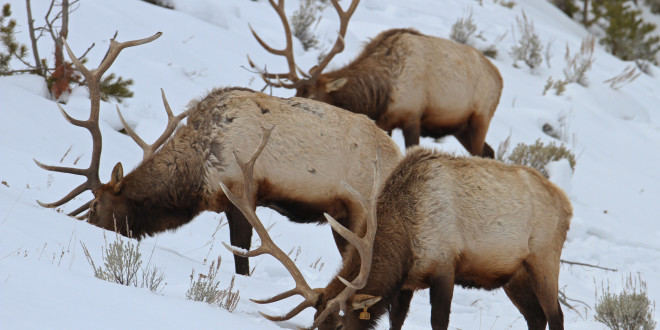The Buffalo Bill Historical Center of the West (BBHC) has released details concerning their new wildlife exhibit.
Invisible Boundaries: Exploring Yellowstone’s Great Animal Migrations will take visitors on a trek through the Greater Yellowstone Ecosystem, tracking animals as they migrate across the landscape—and across lines they’re not supposed to cross. From a BBHC press release:
Organized by the Draper Museum, Invisible Boundaries demonstrates that drawing political lines on a map, without attention to historical and critical movement patterns of wildlife, is a recipe for conflict. When searching for winter resources, animals like elk and deer exit the Park and migrate into surrounding multiple-use and private lands, crossing human-imposed boundaries. Indeed, those borders, i.e. national parks and forests, tribal lands, state governments, and the like, don’t really exist for the wildlife of the area.
The long-term conservation of Yellowstone’s migratory wildlife depends on the actions of landowners and other stakeholders far beyond national park borders. Invisible Boundaries uses stunning photographs and video, interactive migration maps, cultural objects, and original artwork by James Prosek to convey the compelling story of animal migrations of not only the Greater Yellowstone Ecosystem, but those of humpback and gray whales, monarch butterflies, and Swainson’s hawks, among others. Then, the exhibition examines the reasons behind these amazing journeys and shares cutting-edge conservation science in one of the world’s most renowned natural heritage sites.
“We are proud to join with the National Park Service in observance of their 100th Anniversary this year,” Charles R. Preston, Draper Museum curator says. “Invisible Boundaries is an excellent way for us to share in that celebration.”
The Center of the West has organized Invisible Boundaries through its Draper Natural History Museum and Whitney Western Art Museum, in partnership with Yale University’s School of Forestry and Environmental Studies, the Yale Institute for Biospheric Studies, the Wyoming Migration Initiative of the University of Wyoming, and with exhibition designer, Split Rock Studios. The exhibition is supported in part by the William H. Donner Foundation.
We previously reported on the pair responsible for the substance of Invisible Boundaries: research biologist Arthur Middleton and photographer Joe Riis, who were highlighted by National Geographic magazine. We also briefly mentioned the exhibit would be opening at the BBHC later in the year, to coincide with the pair’s appearance in the May 2016 issue of National Geographic.
The Draper exhibit will coincide, in part, with another special exhibit in the BBHC. The Whitney Western Art Museum will be featuring rare “Albertypes” made from a set of negatives taken by William Henry Jackson on the 1871 Hayden Geological Survey, to be featured between March 21 and August 14, 2016.
 Yellowstone Insider Your Complete Guide to America's First National Park
Yellowstone Insider Your Complete Guide to America's First National Park





